Do You Have Reptile Dysfunction?
December 2009
- by Kelvin Miyahira
Reptile Dysfunction is a serious degenerative swing disease that afflicts millions of golfers around the globe. It is characterized by absence of reptilian body movements, which in turn cause low swing speeds, anemic driving distances and chronic swing maladies. If you suffer from these symptoms, you'll need to take some athletic medicines to cure you of it.
What do I mean by that? As I wrote about the spine engine and its role in the golf swing, there's much more to it than you can imagine. Since I covered the downswing moves of the spine engine perhaps it is time to go back and figure out how to move like a reptile throughout your whole swing and it starts with your backswing.
The Pretty Backswing
One of the forms Reptile Dysfunction (RD) can take is the pretty backswing. The pretty backswing is very common and perhaps one of the reasons for this is the Golf Digestization of the golfing world. By learning much of your golf from reading golf magazines and books, you are fed a monthly diet of still pictures.
Still pictures are great for showing the address position but is it a good idea to show a still picture for the top of the backswing position? Could it be why people have difficulty learning the micro moves that occur in transition?
Add in that people like to see nice geometrical lines in things and you've got the recipe for a pretty swing.
Here's a question for you. Which backswing looks prettier?
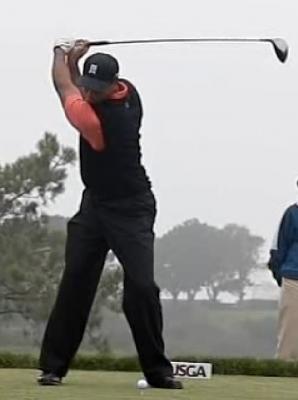
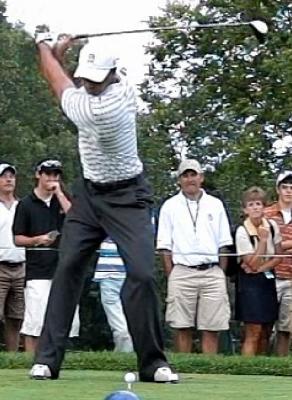
What you're looking at is Tiger 2008 in the black vest and Tiger 2009 in the white stripe shirt. So would you say that Tiger 2009 looks prettier? You can see a straighter left arm, straighter back, more centered lower body, less shift to the right with the upper body and the perfect 90 degree shoulder turn with minimal hip turn and leg movements.
If you answered "Yes! Tiger 2009 looks prettier" you are probably in the majority. But the next question is, "Is prettier better?" We'll answer that by the end of the article.
Efficient Backswing
Another form of RD is the efficient swing. It is somewhat related to the pretty swing but by using Athletic Illogic, some teachers believe that reducing all extraneous movements is the way to power and consistency.
One of most common ways of obtaining an efficient swing is to restrict your hip turn.
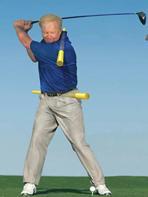
Here's Jim McLean demonstrating the efficient swing by restricting hip turn. McLean started this pretty swing method with his X-Factor way back in 1997. Biomechanical systems of today are still using this method of characterizing a backswing's worthiness based on how many degrees of shoulder turn you have in comparison to your hip turn. The ideal he said was 90 degrees of shoulder turn with 45 degrees of hip turn.
But what if your body does not fit the Twiggy model nor are you flexible enough to do that type of swing? Or what if you want to hit it farther? Should you still follow that model?
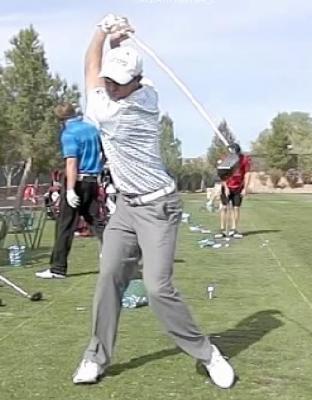
Maybe Jamie Sadlowski might be a better model if you want to hit it farther? He's probably got 55 degrees hip turn and maybe a 120 degrees of shoulder turn. And as we'll see later, he's got all sorts of "extra" moves that people would say he should get rid of.

Or how about swinging like a golf legend? Turn your hips 80-90 degrees like Bobby Jones. As long as you have a good transition move with a closed hip bump, you'll hit it better this way than if you restrict your hip turn as everyone says.
Another common way of achieving efficiency is by removing all head movement.
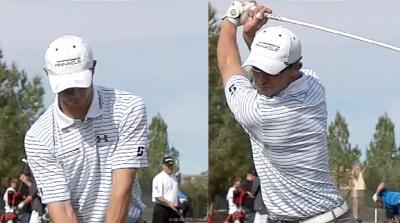

Jamie's head moves up, to the right and rotates to the right. McLean has his head rock steady and not moving.
Well what if I told you that many golfers come over the top because after restricting all this motion and winding up so tightly on the backswing, they just fire hard from the top. More technically, these golfers are reaching max stretch or tension positions on the backswing and this sets off stretch shorten cycles (SSC's) that CANNOT be avoided. And the only way to fix that is to reach your max stretch/tension positions on the downswing.
If this sounds like you, stop trying to be pretty.
The Stable Backswing
Current biomechanical methods used by K- Vest and TPI judge a backswing by stability. These methods seek a rotation of the upper body while the lower body remains stable. It is similar to the X-Factor since McLean used similar biomechanical data to create this model.
But taking this a step further, biomechanical systems seek to have your pelvis or lower spine rotate but eliminate all other motions in terms of any tilting as in the anterior or posterior pelvic moves, bending the spine up or down (as Jamie and Tiger do) or side bending (sway or lateral motion).
Does that sound good to you? I'm sure it does. When the instruction is framed as seeking efficiency by removing all excess motion it sounds like it could be the silver bullet that will make you better. Sounds logical right?
But it doesn't make any athletic sense to me. So let's take closer look at this. To help us decide what looks better, I've enlisted the help of Tom Agricola from Alabama, a 3 handicapper with a pretty swing (he's working on it though).
Let's play the famous Sesame Street game called "Which one of these is not like the others?"
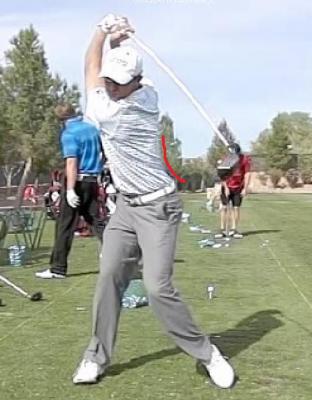
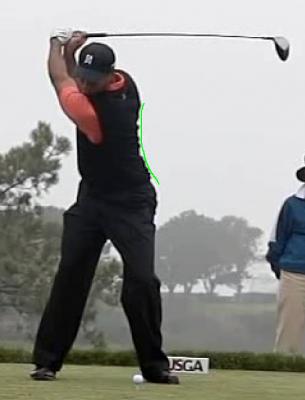
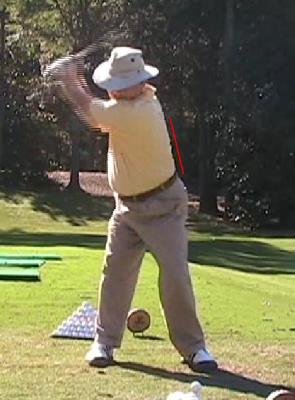
Hmmmmm. If you guessed the third picture, Tom. You're right! Tom's lower spine looks dead straight like Jim McLean's in the X-Factor picture. Tom's biomechanical graphs would look better than the other two guys because he's more stable. He has less anterior pelvic tilt as shown by the straightness of his lower spine.
So let's play the round two of "Which one of these is not like the others?"
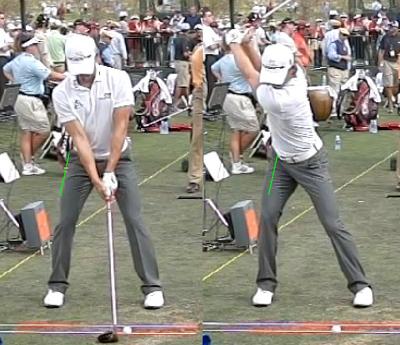
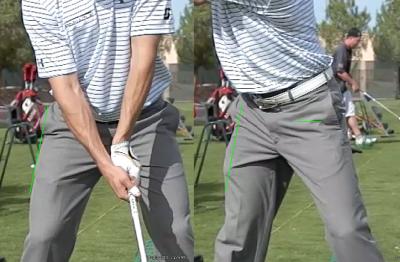
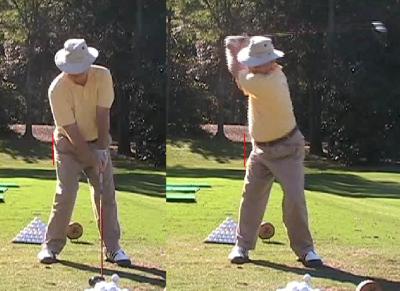
Okay, once again if you answered "Tom" you're right again. Both Camilo Villegas and Jamie have a right side loading whereas Tom is much more centered. Tom wastes no motion swaying back so he won't have to shift back as far to the left and he's there at impact right? Athletic illogic.
Round 3
I've drawn a horizontal line of where the belt line is at address and the second picture is when they are nearing the end of their backswings. So which one does not look like the others?
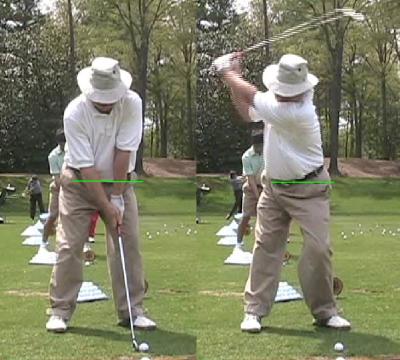

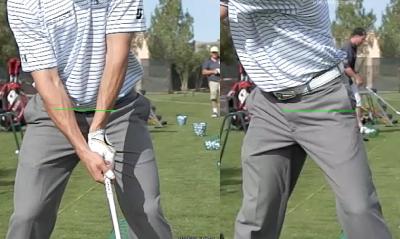
Correct answer? Once again it is Tom. If you look carefully, Tom's belt line stays very level whereas Tiger's goes slightly up. And Jamie? He's raising up a few inches.
Bottom line
So as you can tell Tom has a very pretty golf swing. It is both efficient and stable in the modern lingo. But as you can tell, the best in the world are NOT pretty (though Tiger 2009 is looking pretty), efficient nor stable. They are what they are. They move more like reptiles than robots. And they hit it a lot farther and straighter than anybody with RD.
And just maybe the reason amateurs get stuck in a rut and can't improve is because they've removed so much of their dynamic nature and have become frozen and robotic. But there's help on the way. Let's go look at the micro moves of a great backswing.
Micro Moves of a Reptilian Backswing
To understand the ill effects of reptile dysfunction, let's take a closer look at four important micro moves of a great backswing.
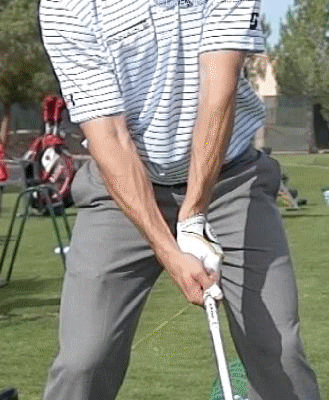
Jamie's Upload
Borrowing the term from computer technospeak, uploading makes perfect sense when you know that a drop of your body is helpful in creating more power. According to the Physics of Golf by Theordore Jorgensen, 13% more power can be gained by using gravity. If that's not enough motivation, Jamie and Tiger both use gravity by employing a downward move in the downswing.

Anterior Pelvic Tilt
Proper loading of the spine engine is due to a small amount of anterior pelvic tilt (APT) that occurs in the end of the backswing and transition. Shown by the green line on the lower spine, this slight arching of the spine is one of the most powerful moves your spine can set yourself up to make. The movement from APT back to neutral in the spine is a natural, powerful athletic motion that is found in many sports. Think of the Andy Roddick serve in tennis, Tim Lincecum's pitching motion, etc. Any powerful, athletic movement is probably using APT to neutral to provide extra power.
Imagine trying to throw a baseball hard with a stiff, locked torso. You'd just throw with your arms right? Well that's the way many golfers are swinging with their robotic backswings.
Note: APT does not reach a maximum tilt during the backswing. It should reach max point during transition. Should max APT occur on the backswing, it will cause a motion more similar to throwing a sack of potatoes over your right shoulder to the ball. In other words, it will cause an over-the-top move.
Nor should APT occur late during the downswing. If a golfer should stay in a neutral position on the backswing, then move into APT in the middle of the downswing, you've got the recipe for the hip thrust syndrome. So if you lose your spine angle at impact and are thrusting your hips out towards the ball at impact, you've probably got APT occurring too late to help power your swing correctly.
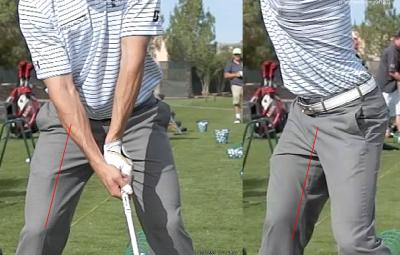
Right Hip External Rotation
Another micro move is the external rotation of the right hip. Notice the red line drawn on Jamie's right thighbone or femur at address. This shows the rotational movement of his right hip from address to the top of his backswing. His knee is rotated outwards as well as his hip.
In comparison, Tom's right leg appears to be locked to the hips. Held artificially in internal rotation, it causes premature shift to the left leg. Perhaps Tom has thoughts of keeping his weight inside of the feet? Whatever the case, it destroys any chance for a powerful and meaningful weight shift to the left. Would you throw a ball by shifting your weight to your front foot at the beginning of your windup? Illogical.
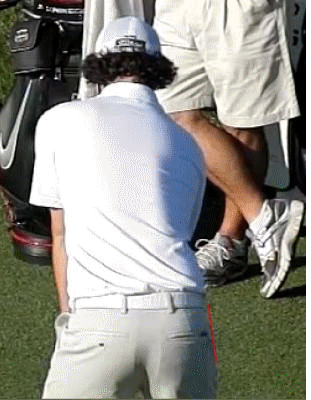
Right Gluteus Load
This one is a bit tougher to see but Rory McIlroy has a lot more right glute load. You can see that his right butt cheek is jutting out towards the camera. This loads his gluteus maximus, the big butt cheek muscle as well as the gluteus medius and minimus, which are on the side of his hip.
Tom has his right butt cheek angled toward the target. This shows that Tom is loading his left leg. This looks like a minor problem but as we'll see later, this is the root of some of his problems. But Tom sure does look pretty.
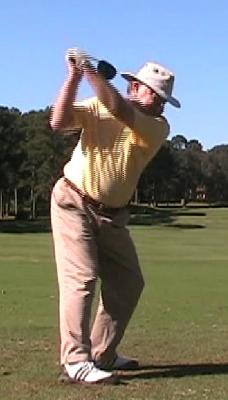
Target Line View
In case you're wondering, Tom does have a great looking backswing from target line view. So it doesn't look like he has any backswing plane issues.
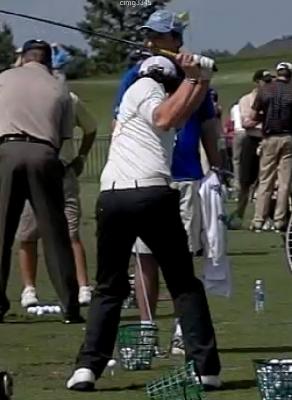
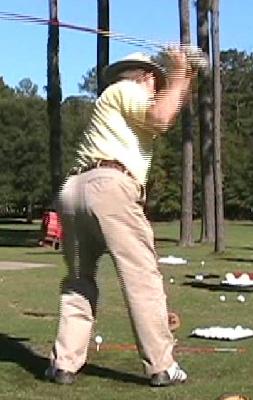
Reptilian Transition
Rick calls this the "Anaconda Position" and for good reason. Rory is all twisted and contorted just as we've seen Tiger and Bubba Watson similarly. Whereas Tom looks like he could be posing for a picture instead of swinging dynamically.
Rory's spine is bent in three distinct ways. One is he is still in APT. His left side still shows some arch though it is starting to return to neutral in a powerful way.
Two, his right shoulder is lowering towards his right hip. His right lat and rotator cuff muscles are pulling his right elbow down and to his side whereas Tom's right elbow is farther away from his body and firing forward.
Three, his right shoulder is slightly arching back towards his spine by a nano move called the scapula dig move. This scapula dig move occurs as your chest and serratus muscles (boxer's muscles that are to be used near impact) are being stretched maximally by your latissimus dorsi. This is an incredibly powerful move that goes unused by many golfers as they lock up their scapula with their torso and just turn the whole robotic unit.
These contortions of the spine are initiating SSC's to fire later in the downswing. Combined with the lower body movements that were covered in an earlier article, they are what constitute a powerful swing. The more of these muscle groups that get stretched and firing reflexively, the more powerful you will be. As you can imagine Sadlowski has all these moves. And Tiger, oh well.......
Results
Perhaps, judging by prettiness is a bit unfair, subjective and arbitrary. So Rick has done a little biomechanical analysis of Tiger 2008 vs Tiger 2009.
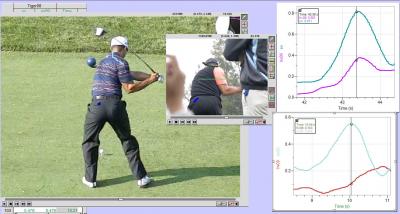
Tiger 2008 had a peak of his shoulders and hips right at impact (vertical black line). Shoulders are in teal and hips are in purple. Contrast, Tiger 2009 has a small hip peak at the beginning of his downswing and stalls midway through the downswing (from sliding beyond the chi line).
Looking at the values though, his shoulders are moving at least 25% slower (8 mph in 2008 vs 6 mph in 2009) and his hips are about 50% slower as well (3 mph in 2008 vs 1.5 mph in 2009). Do you think that explains his loss of distance?
The bottom line is that Reptile Dysfunction can strike anyone. Even the number one player in the world is not immune to the effects of RD (caused by questionable instruction) so be skeptical about swing theory designed to make you pretty and efficient so you won't suffer as well.
And as Tom shows, there's still time to change.
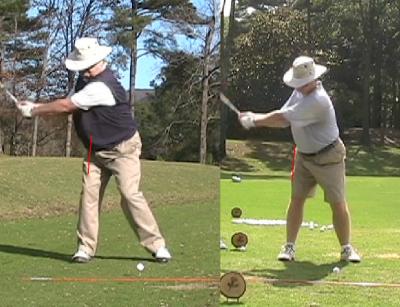
Halfway back, Tom is loading his right side better whereas the old Tom was already shifting left. Although hard to see, he his uploading slightly as well now.
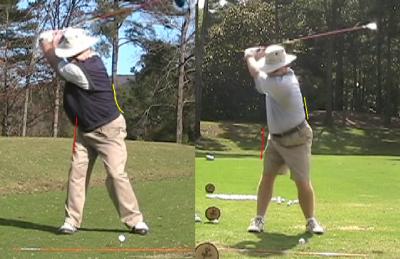
Nearing the end of the backswing, he's starting to move into APT now since we can see a small arching (yellow line). Old Tom looked stiff, straight in his lower spine and pretty.
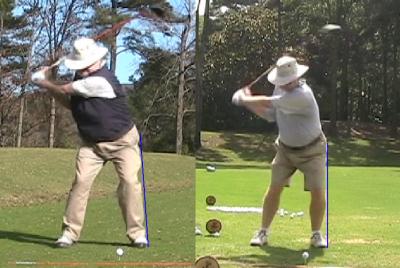
At the end of transition, Tom is in great shape for 2nd fire. He's moved down and left whereas old Tom is already sliding past the chi line and will surely stall.
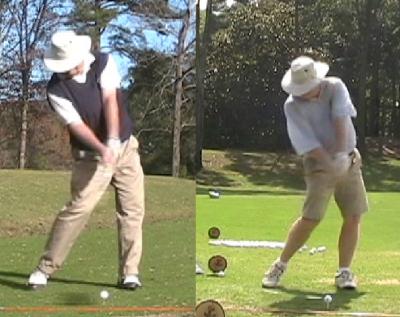
Now Tom looks a little like Hogan and is firing hard with his body. Old Tom is sliding, stalling and hitting with just his hands.
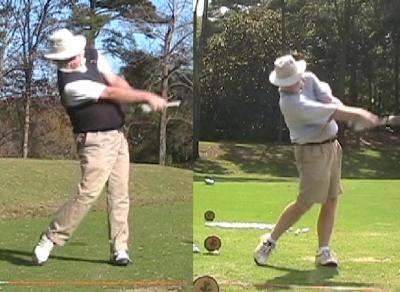
There's also a big difference in the dynamic moves through impact. His shoulders have rotated well vs. old Tom was just rolling his arms through impact. Look closely at his head position. Due to a more powerful body move, his head begins to turn towards the target much earlier.
Adding micro moves has certainly added some power to Tom's swing and it'll be exciting to see how he plays next spring. You can learn to do these moves too.
Medicine Ball Drill
If you've got a medicine ball, we've found a good use for them.
By tossing the ball up and catching it, you will learn to lengthen your transition time. Most people rush transition and begin to lose micro moves. Perhaps this is a good reason Tour Tempo has some relevance.
Also, you will learn how natural it is to use APT during this motion. If you don't have the slight APT while catching the ball, you'll feel stiff and awkward.
Be sure to throw the ball up in the air rather than rolling it. Also, throw to right field vs. at the target line since that is the direction of the force during the downswing.
What do I mean by that? As I wrote about the spine engine and its role in the golf swing, there's much more to it than you can imagine. Since I covered the downswing moves of the spine engine perhaps it is time to go back and figure out how to move like a reptile throughout your whole swing and it starts with your backswing.
The Pretty Backswing
One of the forms Reptile Dysfunction (RD) can take is the pretty backswing. The pretty backswing is very common and perhaps one of the reasons for this is the Golf Digestization of the golfing world. By learning much of your golf from reading golf magazines and books, you are fed a monthly diet of still pictures.
Still pictures are great for showing the address position but is it a good idea to show a still picture for the top of the backswing position? Could it be why people have difficulty learning the micro moves that occur in transition?
Add in that people like to see nice geometrical lines in things and you've got the recipe for a pretty swing.
Here's a question for you. Which backswing looks prettier?


What you're looking at is Tiger 2008 in the black vest and Tiger 2009 in the white stripe shirt. So would you say that Tiger 2009 looks prettier? You can see a straighter left arm, straighter back, more centered lower body, less shift to the right with the upper body and the perfect 90 degree shoulder turn with minimal hip turn and leg movements.
If you answered "Yes! Tiger 2009 looks prettier" you are probably in the majority. But the next question is, "Is prettier better?" We'll answer that by the end of the article.
Efficient Backswing
Another form of RD is the efficient swing. It is somewhat related to the pretty swing but by using Athletic Illogic, some teachers believe that reducing all extraneous movements is the way to power and consistency.
One of most common ways of obtaining an efficient swing is to restrict your hip turn.

Here's Jim McLean demonstrating the efficient swing by restricting hip turn. McLean started this pretty swing method with his X-Factor way back in 1997. Biomechanical systems of today are still using this method of characterizing a backswing's worthiness based on how many degrees of shoulder turn you have in comparison to your hip turn. The ideal he said was 90 degrees of shoulder turn with 45 degrees of hip turn.
But what if your body does not fit the Twiggy model nor are you flexible enough to do that type of swing? Or what if you want to hit it farther? Should you still follow that model?

Maybe Jamie Sadlowski might be a better model if you want to hit it farther? He's probably got 55 degrees hip turn and maybe a 120 degrees of shoulder turn. And as we'll see later, he's got all sorts of "extra" moves that people would say he should get rid of.

Or how about swinging like a golf legend? Turn your hips 80-90 degrees like Bobby Jones. As long as you have a good transition move with a closed hip bump, you'll hit it better this way than if you restrict your hip turn as everyone says.
Another common way of achieving efficiency is by removing all head movement.


Jamie's head moves up, to the right and rotates to the right. McLean has his head rock steady and not moving.
Well what if I told you that many golfers come over the top because after restricting all this motion and winding up so tightly on the backswing, they just fire hard from the top. More technically, these golfers are reaching max stretch or tension positions on the backswing and this sets off stretch shorten cycles (SSC's) that CANNOT be avoided. And the only way to fix that is to reach your max stretch/tension positions on the downswing.
If this sounds like you, stop trying to be pretty.
The Stable Backswing
Current biomechanical methods used by K- Vest and TPI judge a backswing by stability. These methods seek a rotation of the upper body while the lower body remains stable. It is similar to the X-Factor since McLean used similar biomechanical data to create this model.
But taking this a step further, biomechanical systems seek to have your pelvis or lower spine rotate but eliminate all other motions in terms of any tilting as in the anterior or posterior pelvic moves, bending the spine up or down (as Jamie and Tiger do) or side bending (sway or lateral motion).
Does that sound good to you? I'm sure it does. When the instruction is framed as seeking efficiency by removing all excess motion it sounds like it could be the silver bullet that will make you better. Sounds logical right?
But it doesn't make any athletic sense to me. So let's take closer look at this. To help us decide what looks better, I've enlisted the help of Tom Agricola from Alabama, a 3 handicapper with a pretty swing (he's working on it though).
Let's play the famous Sesame Street game called "Which one of these is not like the others?"



Hmmmmm. If you guessed the third picture, Tom. You're right! Tom's lower spine looks dead straight like Jim McLean's in the X-Factor picture. Tom's biomechanical graphs would look better than the other two guys because he's more stable. He has less anterior pelvic tilt as shown by the straightness of his lower spine.
So let's play the round two of "Which one of these is not like the others?"



Okay, once again if you answered "Tom" you're right again. Both Camilo Villegas and Jamie have a right side loading whereas Tom is much more centered. Tom wastes no motion swaying back so he won't have to shift back as far to the left and he's there at impact right? Athletic illogic.
Round 3
I've drawn a horizontal line of where the belt line is at address and the second picture is when they are nearing the end of their backswings. So which one does not look like the others?



Correct answer? Once again it is Tom. If you look carefully, Tom's belt line stays very level whereas Tiger's goes slightly up. And Jamie? He's raising up a few inches.
Bottom line
So as you can tell Tom has a very pretty golf swing. It is both efficient and stable in the modern lingo. But as you can tell, the best in the world are NOT pretty (though Tiger 2009 is looking pretty), efficient nor stable. They are what they are. They move more like reptiles than robots. And they hit it a lot farther and straighter than anybody with RD.
And just maybe the reason amateurs get stuck in a rut and can't improve is because they've removed so much of their dynamic nature and have become frozen and robotic. But there's help on the way. Let's go look at the micro moves of a great backswing.
Micro Moves of a Reptilian Backswing
To understand the ill effects of reptile dysfunction, let's take a closer look at four important micro moves of a great backswing.

Jamie's Upload
Borrowing the term from computer technospeak, uploading makes perfect sense when you know that a drop of your body is helpful in creating more power. According to the Physics of Golf by Theordore Jorgensen, 13% more power can be gained by using gravity. If that's not enough motivation, Jamie and Tiger both use gravity by employing a downward move in the downswing.

Anterior Pelvic Tilt
Proper loading of the spine engine is due to a small amount of anterior pelvic tilt (APT) that occurs in the end of the backswing and transition. Shown by the green line on the lower spine, this slight arching of the spine is one of the most powerful moves your spine can set yourself up to make. The movement from APT back to neutral in the spine is a natural, powerful athletic motion that is found in many sports. Think of the Andy Roddick serve in tennis, Tim Lincecum's pitching motion, etc. Any powerful, athletic movement is probably using APT to neutral to provide extra power.
Imagine trying to throw a baseball hard with a stiff, locked torso. You'd just throw with your arms right? Well that's the way many golfers are swinging with their robotic backswings.
Note: APT does not reach a maximum tilt during the backswing. It should reach max point during transition. Should max APT occur on the backswing, it will cause a motion more similar to throwing a sack of potatoes over your right shoulder to the ball. In other words, it will cause an over-the-top move.
Nor should APT occur late during the downswing. If a golfer should stay in a neutral position on the backswing, then move into APT in the middle of the downswing, you've got the recipe for the hip thrust syndrome. So if you lose your spine angle at impact and are thrusting your hips out towards the ball at impact, you've probably got APT occurring too late to help power your swing correctly.

Right Hip External Rotation
Another micro move is the external rotation of the right hip. Notice the red line drawn on Jamie's right thighbone or femur at address. This shows the rotational movement of his right hip from address to the top of his backswing. His knee is rotated outwards as well as his hip.
In comparison, Tom's right leg appears to be locked to the hips. Held artificially in internal rotation, it causes premature shift to the left leg. Perhaps Tom has thoughts of keeping his weight inside of the feet? Whatever the case, it destroys any chance for a powerful and meaningful weight shift to the left. Would you throw a ball by shifting your weight to your front foot at the beginning of your windup? Illogical.

Right Gluteus Load
This one is a bit tougher to see but Rory McIlroy has a lot more right glute load. You can see that his right butt cheek is jutting out towards the camera. This loads his gluteus maximus, the big butt cheek muscle as well as the gluteus medius and minimus, which are on the side of his hip.
Tom has his right butt cheek angled toward the target. This shows that Tom is loading his left leg. This looks like a minor problem but as we'll see later, this is the root of some of his problems. But Tom sure does look pretty.

Target Line View
In case you're wondering, Tom does have a great looking backswing from target line view. So it doesn't look like he has any backswing plane issues.


Reptilian Transition
Rick calls this the "Anaconda Position" and for good reason. Rory is all twisted and contorted just as we've seen Tiger and Bubba Watson similarly. Whereas Tom looks like he could be posing for a picture instead of swinging dynamically.
Rory's spine is bent in three distinct ways. One is he is still in APT. His left side still shows some arch though it is starting to return to neutral in a powerful way.
Two, his right shoulder is lowering towards his right hip. His right lat and rotator cuff muscles are pulling his right elbow down and to his side whereas Tom's right elbow is farther away from his body and firing forward.
Three, his right shoulder is slightly arching back towards his spine by a nano move called the scapula dig move. This scapula dig move occurs as your chest and serratus muscles (boxer's muscles that are to be used near impact) are being stretched maximally by your latissimus dorsi. This is an incredibly powerful move that goes unused by many golfers as they lock up their scapula with their torso and just turn the whole robotic unit.
These contortions of the spine are initiating SSC's to fire later in the downswing. Combined with the lower body movements that were covered in an earlier article, they are what constitute a powerful swing. The more of these muscle groups that get stretched and firing reflexively, the more powerful you will be. As you can imagine Sadlowski has all these moves. And Tiger, oh well.......
Results
Perhaps, judging by prettiness is a bit unfair, subjective and arbitrary. So Rick has done a little biomechanical analysis of Tiger 2008 vs Tiger 2009.

Tiger 2008 had a peak of his shoulders and hips right at impact (vertical black line). Shoulders are in teal and hips are in purple. Contrast, Tiger 2009 has a small hip peak at the beginning of his downswing and stalls midway through the downswing (from sliding beyond the chi line).
Looking at the values though, his shoulders are moving at least 25% slower (8 mph in 2008 vs 6 mph in 2009) and his hips are about 50% slower as well (3 mph in 2008 vs 1.5 mph in 2009). Do you think that explains his loss of distance?
The bottom line is that Reptile Dysfunction can strike anyone. Even the number one player in the world is not immune to the effects of RD (caused by questionable instruction) so be skeptical about swing theory designed to make you pretty and efficient so you won't suffer as well.
And as Tom shows, there's still time to change.

Halfway back, Tom is loading his right side better whereas the old Tom was already shifting left. Although hard to see, he his uploading slightly as well now.

Nearing the end of the backswing, he's starting to move into APT now since we can see a small arching (yellow line). Old Tom looked stiff, straight in his lower spine and pretty.

At the end of transition, Tom is in great shape for 2nd fire. He's moved down and left whereas old Tom is already sliding past the chi line and will surely stall.

Now Tom looks a little like Hogan and is firing hard with his body. Old Tom is sliding, stalling and hitting with just his hands.

There's also a big difference in the dynamic moves through impact. His shoulders have rotated well vs. old Tom was just rolling his arms through impact. Look closely at his head position. Due to a more powerful body move, his head begins to turn towards the target much earlier.
Adding micro moves has certainly added some power to Tom's swing and it'll be exciting to see how he plays next spring. You can learn to do these moves too.
Medicine Ball Drill
If you've got a medicine ball, we've found a good use for them.
By tossing the ball up and catching it, you will learn to lengthen your transition time. Most people rush transition and begin to lose micro moves. Perhaps this is a good reason Tour Tempo has some relevance.
Also, you will learn how natural it is to use APT during this motion. If you don't have the slight APT while catching the ball, you'll feel stiff and awkward.
Be sure to throw the ball up in the air rather than rolling it. Also, throw to right field vs. at the target line since that is the direction of the force during the downswing.

